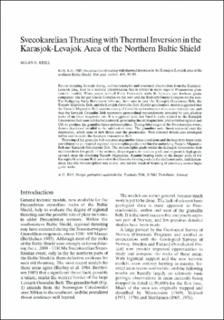| dc.description.abstract | Recent mapping, isotopic dating, and metamorphic and structural observations from the Karasjok-Levajok are, lead to a tectonic interpretation that is similar in many ways to Phanerozoic plate tectonic models. Three major belts of Early Proterozoic rocks lie between two Archean gneiss complexes: the Jer'gul Gneiss Complex on the west and the Baisvarri Gneiss Complex on the east. The E-dipping Early Proterozoic belts are, from west to east: the Karasjok Greenstone Belt, the Tanaelv Migmatite Belt, and the Levajok Granulite Belt. Earlier geochemical studies suggested that the Tanaelv Migmatite Belt consists mainly of tholeiitic metavolcanites of an outer volcanic are, and that the Levajok Granulite Belt represents geosynclinal metasediments intruded by calc-alkaline rocks of an inner magmatic arc. It is suggested here that basaltic rocks related to the Karasjok Greenstone Belt were subducted eastward, generating the arc magmatism, and contributing heat and CO2 to produce the granulite-facies metamorphism. During later stages of the Svecokarelian event, thrusts developed parallel to the subduction zone. The granulites were thrust westward over the migmaties, which were in turn thrust also developed within and beneath the Karasjok Greenstone Belt. Thrusting of the granulite belt occurred at granulite-facies conditions and the heat from these rocks contributed to an inverted regional metamorphic gradient within the underlying Tanaelv Migmatite Belt and Karasjok Greenstone Belt. The metamorphic grade within the Karasjok Greenstone Belt increases from low grade in the western, deepest parts, to medium grade and migmatitic high grade upward, near the overlying Tanaelv Migmatites. Kyanite-bearing rocks in the deeper parts of the Karasjok Greenstone Belt contrast with sillimanite-bearing rocks in the shallower parts, and demonstrate that the metamorphism was in-situ, and n | |

